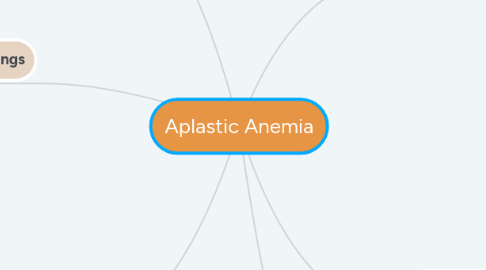
1. Diagnostic Tests
1.1. Laboratory Tests
1.1.1. Complete blood count Peripheral blood smears Hemoglobin electrophoresis and blood-group testing Biochemical profile Serology for hepatitis and other viral entities Autoimmune-disease evaluation for evidence of collagen-vascular disease Fluorescence-activated cell sorter profiling Fluorescent-labeled inactive toxin aerolysin testing Diepoxybutane incubation Histocompatibility testing Kidney function studies Liver function studies Transaminase, bilirubin, and lactate dehydrogenase levels
1.2. Bone Marrow Biopsy
2. Common Findings
2.1. Anemia
2.1.1. pallor, headache, palpitations, dyspnea, fatigue, or foot swelling
2.2. Thrombocytopenia
2.2.1. mucosal and gingival bleeding or petechial rashes
2.3. Neutropenia
2.3.1. overt infections, recurrent infections, or mouth and pharyngeal ulcerations
3. Treatments
3.1. Pharmacotherapy
3.1.1. Immunosuppressive agents
3.1.1.1. For individuals unable to undergo bone marrow transplant or who lack a suitable sibling donor, immunosuppression is the treatment of choice
3.1.1.1.1. e.g.: cyclosporine, methylprednisolone, equine antithymocyte globulin, rabbit/horse antithymocyte globulin, cyclophosphamide, alemtuzumab
3.1.2. Hematopoietic growth factors
3.1.2.1. e.g.: eltrombopag, sargramostim, filgrastim
3.1.3. Antimetabolite (purine) antineoplastic agents
3.1.3.1. e.g.: Fludarabine
3.1.4. Chelating agents
3.1.4.1. e.g.: deferoxamine, deferasirox
3.2. Non-pharmacotherapy
3.2.1. Supportive care
3.2.2. Blood transfusions with blood products that have undergone leukocyte reduction and irradiation
3.2.3. Hematopoietic cell transplantation
3.2.3.1. Allogeneic stem cell transplantation from HLA-matched sibling donor is a preferred first-line treatment option for younger patients with severe or very severe AA
3.3. Surgical
3.3.1. Central venous catheter placement is necessary before the administration of hematopoietic cell transplantation
4. Pathophysiologic Etiology
4.1. Aplastic anemia (AA) is clinical syndrome characterized by fatty replacement and decreased hematopoietic precursors of the bone marrow, which results in peripheral blood pancytopenia
4.2. Most cases of idiopathic AA result from an autoimmune disease directed against hemotopoietic stem cells
4.2.1. Studies suggested that immune-mediated destruction of hematopoietic stem cells by activated cytotoxic T-cells expressing inhibitory cytokines such as interferon-γ and tumor necrosis factor-α contribute to its occurrence
4.2.1.1. These cytokines partially induces death of hematopoietic stem cells through the Fas-dependent pathway of apoptosis
4.2.1.2. The mechanism of activation of cytotoxic T-cells is unclear, but several potential factors which are associated with antigen recognition, susceptibility of immune response, and secretion of cytokines are found
5. Causative Factors
5.1. Inherited
5.1.1. Congenital or inherited causes of aplastic anemia are responsible for at least 25% of children with this condition and for perhaps up to 10% of adults.
5.1.1.1. e.g.: Fanconi anemia, Shwachman-Diamond syndrome, Dyskeratosis congenita, Diamond-Blackfan anemia, familial aplastic anemia, cartilage-hair hypoplasia, Pearson syndrome, Dubowitz syndrome
5.2. Acquired
5.2.1. Approximately 80% of Aplastic anemia are due to acquired causes
5.2.1.1. Idiopathic factors Infectious causes, such as hepatitis viruses, Epstein-Barr virus (EBV), human immunodeficiency virus (HIV), parvovirus, and mycobacteria Exposure to ionizing radiation Exposure to toxic chemicals, such as benzene or pesticides [27] Transfusional graft versus host disease (GVHD) Orthotopic liver transplantation for fulminant hepatitis Pregnancy Eosinophilic fasciitis Anorexia Severe nutritional deficiencies (B12, folate) Paroxysmal nocturnal hemoglobinuria Myelodysplastic Syndrome Acute lymphoblastic leukemia (ALL)(rarely)
6. Risk Factors
6.1. Exposure to toxic chemicals
6.2. Treatment with high-dose radiation or chemotherapy for cancer
6.3. The use of some prescription drugs
6.3.1. chloramphenicol
6.3.1.1. used to treat bacterial infections
6.3.2. gold compounds
6.3.2.1. used to treat rheumatoid arthritis
